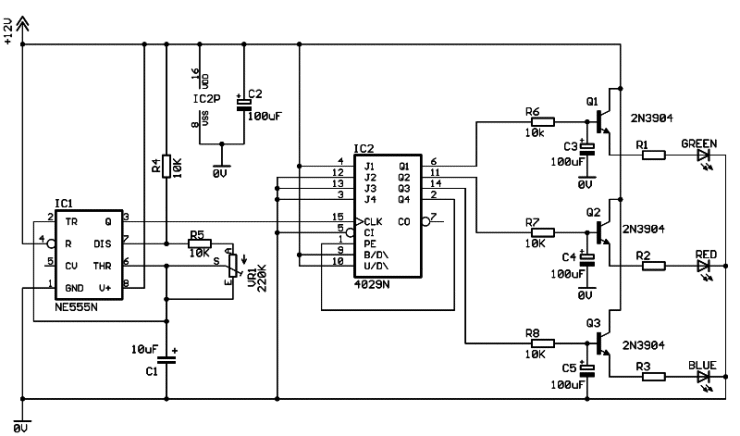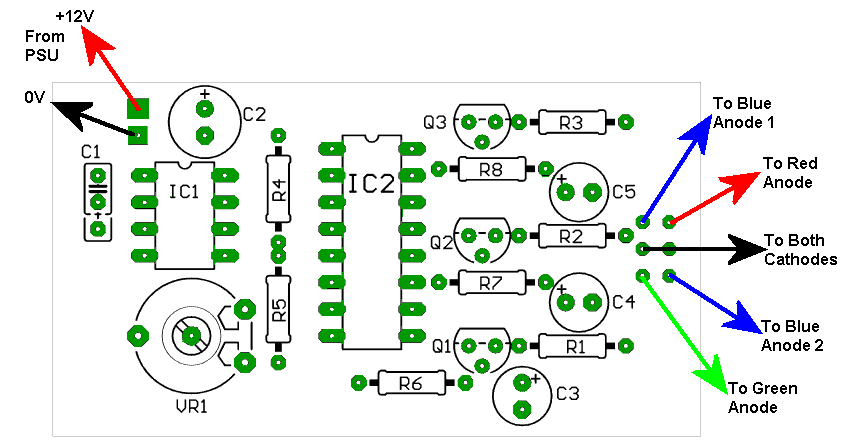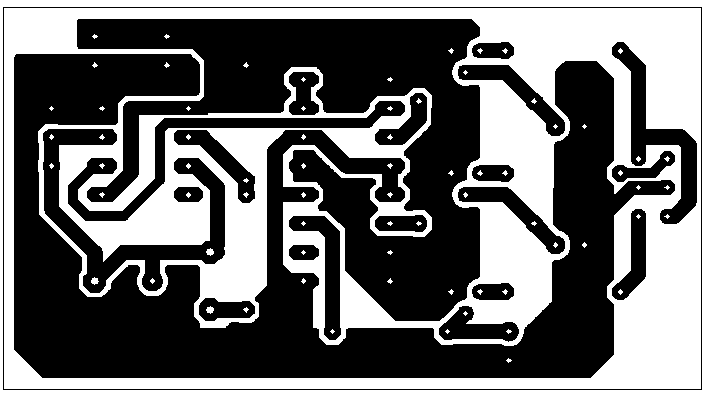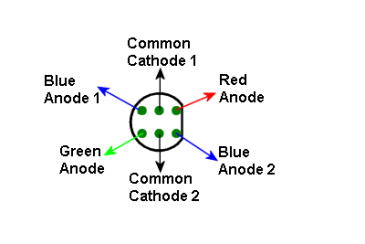| |
The implementation of a RGB LED fader using 555 timer and 4029 digital IC is the objective of this project.
During the operation, the RGB LED is continuously cycled through the colors of the rainbow where the speed at which the colors change is adjustable. The switch between the different colors makes the effect very noticeable while a more relaxed effect happens when the colors fade into each other. These two options can be selected on this device.
The pulse generator based form a standard 555 timer is formed by IC1, C1, R4, R5, and VR1. The frequency of which, and hence the speed of the effect, as adjusted using the pre-set VR1. The pulses are fed into IC2 which is a 4029 binary counter whose outputs continuously count in a binary progression between 1 to 7. The transistors Q1, Q2, and Q3 are being driven by these outputs which in turn control each of the three colors of the RGB LED.
By passing through an RC network, the pulses are shaped before they reach their respective transistors. The fading effect between the colors or abrupt changing is produced by this shaping.

Right, let's get straight to the point. This is a little eye-candy circuit which continuously cycles an RGB LED through the colours of the rainbow. The speed at which the colours change is adjustable.
The circuit has two options:
1. Switch between the different colours. This makes the effect very noticeable.
2. Have the colours fade into each other. This is a more relaxed effect and one I find very pleasing. The choice is yours.
The cost is about £2 (ish) plus the LED and PCB
At this point I was planning on having a video of the circuit in action but the exposure on my video camera is only fully automatic. This makes it impossible to get even a half decent clip of a concentrated light source such as an LED. Anyway, the concept is pretty straight forward so your imagination should give you the picture.
Moving swiftly on, here's how the circuit works:
IC1, C1, R4, R5 and VR1 form a standard "555 timer" based pulse generator. The frequency of which, and hence the speed of the effect, is adjusted using the pre-set VR1.
These pulses are fed into IC2, a 4029 binary counter whose outputs continuously count in a binary progression between 1 to 7. These outputs drive the transistors Q1, Q2 and Q3 which, in turn, control each of the three colours of the RGB led.
The pulses are"shaped" by passing them through an RC network before they reach their respective transistors. This "shaping" produces the fading effect between the colours.
The fade in/out time can be altered by changing the value of the capacitors. (C3, C4, C5). Reducing the value to 47uF will reduce the time to fade between colours. Conversely, increasing the capacitance to 200uF will take longer. The value of 100uf for the "fade" capacitor was found by testing to be the most suitable over a wide speed setting range. You may want to experiment with different values, especially at very high and low speed settings. Do not change the R6, R7 and R8 values as this will affect the led current and may damage it.
As stated previously, the circuit can be used without the fading effect and having the colours abruptly change. To do this, just do not fit the fade capacitors, C3, C4 and C5.
A note about the led limiting resistors, R1, R2 and R3. The values shown in the table were derived from calculation and then trimmed to the nearest preferred value by experimentation. The chosen values produce good results without over loading the led. If you use an RGB led with different specs, you may need to use different resistor values, although the circuit should still work using the current values.
The PCB foil pattern below is clickable for a 4x life-size image. Use the 4x image to produce the art work to make the board. The image needs to be reduced to 25% when printing to produce the life-sized foil. Load the foil pattern image into a drawing package such as Paint Shop Pro to print it. Do the reduction at the PRINTING stage and NOT using the resize image tools within the drawing package. Using this reduction method produces sharp artwork.
EAGLE users can download the PCB layout here. The free version of EAGLE can be downloaded here. Or from the Eagle web site download page.
The board size, (the rectangle around the foil), is 34mm x 61mm.
All holes are 0.8mm with the exception of the holes for VR1. These are 1.2mm.
When assembling the PCB start with the smallest components first, working your way up. (Resistors, IC's, transistors, pre-set, capacitors).
RGB LED Specs
RED If = 30mA, Vf = 2.0V
GREEN If = 25mA, Vf = 2.2V
BLUE If = 30mA, VF = 4.5V
LED pin outs viewed from underneath.
Here's a picture of the completed Rainbow LED. The led can be mounted off board using wires which will make it easier to panel mount.




Related Links
Downloads
RGB LED Driver - Link
|
|
|
| |
Accurate LC Meter
Build your own Accurate LC Meter (Capacitance Inductance Meter) and start making your own coils and inductors. This LC Meter allows to measure incredibly small inductances making it perfect tool for making all types of RF coils and inductors. LC Meter can measure inductances starting from 10nH - 1000nH, 1uH - 1000uH, 1mH - 100mH and capacitances from 0.1pF up to 900nF. The circuit includes an auto ranging as well as reset switch and produces very accurate and stable readings. |
|
PIC Volt Ampere Meter
Volt Ampere Meter measures voltage of 0-70V or 0-500V with 100mV resolution and current consumption 0-10A or more with 10mA resolution. The meter is a perfect addition to any power supply, battery chargers and other electronic projects where voltage and current must be monitored. The meter uses PIC16F876A microcontroller with 16x2 backlighted LCD. |
|
|
|
60MHz Frequency Meter / Counter
Frequency Meter / Counter measures frequency from 10Hz to 60MHz with 10Hz resolution. It is a very useful bench test equipment for testing and finding out the frequency of various devices with unknown frequency such as oscillators, radio receivers, transmitters, function generators, crystals, etc. |
|
1Hz - 2MHz XR2206 Function Generator
1Hz - 2MHz XR2206 Function Generator produces high quality sine, square and triangle waveforms of high-stability and accuracy. The output waveforms can be both amplitude and frequency modulated. Output of 1Hz - 2MHz XR2206 Function Generator can be connected directly to 60MHz Counter for setting precise frequency output. |
|
|
|
BA1404 HI-FI Stereo FM Transmitter
Be "On Air" with your own radio station! BA1404 HI-FI Stereo FM Transmitter broadcasts high quality stereo signal in 88MHz - 108MHz FM band. It can be connected to any type of stereo audio source such as iPod, Computer, Laptop, CD Player, Walkman, Television, Satellite Receiver, Tape Deck or other stereo system to transmit stereo sound with excellent clarity throughout your home, office, yard or camp ground. |
|
USB IO Board
USB IO Board is a tiny spectacular little development board / parallel port replacement featuring PIC18F2455/PIC18F2550 microcontroller. USB IO Board is compatible with Windows / Mac OSX / Linux computers. When attached to Windows IO board will show up as RS232 COM port. You can control 16 individual microcontroller I/O pins by sending simple serial commands. USB IO Board is self-powered by USB port and can provide up to 500mA for electronic projects. USB IO Board is breadboard compatible. |
|
|
|
|
ESR Meter / Capacitance / Inductance / Transistor Tester Kit
ESR Meter kit is an amazing multimeter that measures ESR values, capacitance (100pF - 20,000uF), inductance, resistance (0.1 Ohm - 20 MOhm), tests many different types of transistors such as NPN, PNP, FETs, MOSFETs, Thyristors, SCRs, Triacs and many types of diodes. It also analyzes transistor's characteristics such as voltage and gain. It is an irreplaceable tool for troubleshooting and repairing electronic equipment by determining performance and health of electrolytic capacitors. Unlike other ESR Meters that only measure ESR value this one measures capacitor's ESR value as well as its capacitance all at the same time. |
|
Audiophile Headphone Amplifier Kit
Audiophile headphone amplifier kit includes high quality audio grade components such as Burr Brown OPA2134 opamp, ALPS volume control potentiometer, Ti TLE2426 rail splitter, Ultra-Low ESR 220uF/25V Panasonic FM filtering capacitors, High quality WIMA input and decoupling capacitors and Vishay Dale resistors. 8-DIP machined IC socket allows to swap OPA2134 with many other dual opamp chips such as OPA2132, OPA2227, OPA2228, dual OPA132, OPA627, etc. Headphone amplifier is small enough to fit in Altoids tin box, and thanks to low power consumption may be supplied from a single 9V battery. |
|
|
|
|
|
Arduino Prototype Kit
Arduino Prototype is a spectacular development board fully compatible with Arduino Pro. It's breadboard compatible so it can be plugged into a breadboard for quick prototyping, and it has VCC & GND power pins available on both sides of PCB. It's small, power efficient, yet customizable through onboard 2 x 7 perfboard that can be used for connecting various sensors and connectors. Arduino Prototype uses all standard through-hole components for easy construction, two of which are hidden underneath IC socket. Board features 28-PIN DIP IC socket, user replaceable ATmega328 microcontroller flashed with Arduino bootloader, 16MHz crystal resonator and a reset switch. It has 14 digital input/output pins (0-13) of which 6 can be used as PWM outputs and 6 analog inputs (A0-A5). Arduino sketches are uploaded through any USB-Serial adapter connected to 6-PIN ICSP female header. Board is supplied by 2-5V voltage and may be powered by a battery such as Lithium Ion cell, two AA cells, external power supply or USB power adapter. |
|
200m 4-Channel 433MHz Wireless RF Remote Control
Having the ability to control various appliances inside or outside of your house wirelessly is a huge convenience, and can make your life much easier and fun. RF remote control provides long range of up to 200m / 650ft and can find many uses for controlling different devices, and it works even through the walls. You can control lights, fans, AC system, computer, printer, amplifier, robots, garage door, security systems, motor-driven curtains, motorized window blinds, door locks, sprinklers, motorized projection screens and anything else you can think of. |
|
|
|